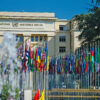“Hajj is the manifestation that in Islam all roads lead to the House of Allah, where nationality, ethnicity and different beliefs are blown away. Hajjis come from everywhere, from every country, every continent and every background. They fly, sail and travel by land. Whoever they are, wherever they come from and however they come, they are attracted by only one thing and one point: the desire to worship Allah at His House and complete the hajj rituals.” This is how a British Muslim described his experience in 1976.
“The journey to the House of Allah is unique,” writes British scholar Shaykh Abdalhaqq Bewley. Nothing comparable happens on our planet, he said. “It represents the only truly global pattern of human behaviour.” Another aspect that is often lost sight of is the age of the Hajj and the fact that Muslims, by participating, are continuing an unbroken tradition that has existed uninterrupted since the dawn of human history, Bewley says. “It‘s been at least six thousand years since the Prophet Ibrahim instituted the rites of Hajj with the house he built in the valley of Mecca at its centre, and it’s been taking place at that site year after year ever since.”
Those who complete their Hajj with inner sincerity and outer observance come back transformed. His life takes on a new and more meaningful quality. “They are the ones the Prophet spoke of as if they were new-born. For them, the Hajj really acts as a new beginning for their lives.”
As global as it goes back deep into human history, it is just as formative for Muslims around the world. While believers from the world’s affluent zones or elites have an almost blasé attitude to it, sometimes treating the Hajj like a tourist trip, it is even more important to poorer people. This is partly because they must save for it for many years. Quite a few journey to Mecca or Medina in the knowledge that they can either die there or will.
This importance of the hajj for many, for whom it is only possible once in a lifetime and is indeed “arduous,” is reflected in localised traditions. Hajjis are either ceremonially seen off or received in their communities. In some regions, they are given the honourific epithet Haji/Hajjah upon successful completion. In others, they have elements of the journey such as the Kaaba painted on their house walls.
Despite its ancestral and timeless rites dating back to the archaic, this journey of a lifetime has also changed, at the latest with the advent of steamships, railways and other modern means of transport. Since it has taken place under the aegis of the Saudi state, it has been steadily streamlined and managed. On the one hand, these measures have led to noticeable improvements such as air-conditioning and modern means of transport between the different stages of the journey.
On the other hand, it has become infinitely more restricted today, organised by the relevant Saudi ministry. Unlike citizens of the Gulf Cooperation Council, all other visitors are subject to quota regulations for their respective countries of origin. Travelling to the region with a freely chosen means of transport as part of an autonomous group has not been possible for a long time. For quite some time, the Hajj was only permitted for visitors from Europe or North America via licensed organisers and as part of one of their groups.
But even this limited access has recently become a thing of the past according to Saudi will. As the ministry responsible for Hajj and Umrah announced on 6 June, Muslims in Europe, America and Australia now must apply for the Hajj via a website (www.motawif.com.sa). Critics therefore already spoke of “discrimination” against Muslims from countries that do not have national Hajj delegations.
Accordingly, a place will be drawn by lot among those interested. People over 65 and those who had already made the pilgrimage once are excluded. For the rest, there will be a lottery, as has been the case before in most Muslim-majority countries. The organisation of accommodation, travel to and from the pilgrimage as well as the supervision of the groups will also no longer be carried out by previous providers. The rumoured costs for the ministry’s new compulsory packages are not small either. The individual Hajj is said to cost between 5,100 and 6,500 euros for travellers from the West.
The ministry has asked all pilgrims to “claim refunds from tour operators/agents” with whom they had already “booked” the Hajj for 2022. Many Muslims in the West – potential pilgrims and travel agents – have expressed shock and disappointment at these new regulations. For countless potential hajjis, the desire to go on Hajj 2022 was dashed. For others, re-registering meant massive additional costs. Some reported that no visit to Medina is possible in the new packages.
“We’ve been doing Umrah and Hajj for many years,” explained one organiser in London, “and it’s very difficult to get anything out of the ministry so it’s a mystery how pilgrims are going to get what they need.” This, he said, was a totally avoidable situation. The time taken to set up the portal and the operational processes is not insignificant, he said. “This must have been known weeks, if not months, ago. The pilgrims were clearly not a priority here, and the impact on them and the facilitators is enormous,” news portal The New Arab quoted another provider as saying.
In addition, according to the Saudi expert lawyer Dimah Talal Alsharif, the responsible ministry has presented a new catalogue of penalties. The listed rule violations include entering places like Mina, Muzdalifa or Arafat in the Ihram without permission. Those who break these rules and are not from Gulf Cooperation Council countries will be deported from Saudi Arabia and prevented from entering again.











